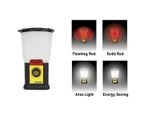Coast LED Emergency Lantern 375 Lumen

When emergencies strike, the only light necessary is reliable, provides a lot of light, lasts a long time and keeps family safe. Coast emergency use LED lanterns were designed to meet those needs-compact, lightweight, and easy to pack; they are great to keep at home or in the vehicle. Their varying options can provide further peace of mind in emergencies with options to signal for help using red LED's, Variable Light Technology (dimming) and a battery life indicator on select models, Battery life is incomparable among others in the category, meaning batteries can be conserved better in emergencies.
LED Lenser is the known brand within the Australian market - COAST outperform Led Lenser in all ANSI Testing - see all the info below in the techical stuff!
The Coast EAL20 LED Lantern is the latest addition to our line of durable and reliable emergency use lights. Its 9 high-quality LED's provide incredible brightness and energy efficiency, giving you up to 80 hours of runtime on one set of (4) D cell batteries (not included). Choose between flashing red, solid red, area light, and energy saving modes; or select your preferred light level with the built-in dimming switch.
Features Include:
- 375 lumen light output
- 80 hour runtime
- Uses (4) D batteries (not included)
- 8.25 inch height
- 9 high quality LED's; 1 white, 8 red
- Push button on/off with VLT Variable Light Technology (dimming) -- choose any light level
- Durable casing
- Built-in battery life indicator
ANSI FL1 flashlight standards explained
Buying a new flashlight, headlamp or lantern these days can be confusing at best. The problem is that there has not been any standardization in the reporting of performance standards of lights from the many manufacturers in the market. A variety of terms such as wattage, candlepower and lumens have been used to measure light output and the method of measuring battery run time was not standardized. This made it nearly impossible to compare features of products produced by different manufacturers. To help alleviate the confusion, a group of the leading companies in the industry joined together to create a new standard of specifications for the portable lighting industry. The resulting ANSI FL1 flashlight standards spell out very specific methods of testing for each feature under controlled laboratory conditions, and will ensure that any light produced by any manufacturer that has adopted the standards can be easily compared for performance and features. Below is a set of icons that participating manufacturers will be using on their packaging and marketing materials along with a description of each specification that each one symbolizes.
lightoutput-single_801Light output - Total light output measured in lumens. Lumens has become the most commonly used unit of measure for total light output in portable lighting devices such as flashlights, headlamps and lanterns. Wattage, on the other hand, is a measurement of power consumption, not light output. With today's super efficient LED technology, it's very possible to have a 1 watt LED flashlight with a greater light output than another flashlight with a higher wattage rating, particularly if the higher wattage light source is less efficient.
beamdist_single_801Beam distance - The distance, measured in meters, at which the light projects a useful amount of light, measured at 0.25 lux. (0.25 lux is approximately the equivalent of light emitted from a full moon "on a clear night in an open field.")
runtime-single_80Run time - Tested with fresh batteries from 30 seconds after the light is turned on until the light output reaches 10% of the initial measurement.
beamintensity-single_80Peak beam intensity - The brightest point in the beam measured in candela. Candela is the modern unit of measure for light intensity replacing the now-obsolete unit known as candlepower. Although candlepower was replaced by candela in 1948, it is still in common use.
impact-single_80Impact resistance - The height, measured in meters, from which the light can be dropped onto cured concrete and still work properly. Dropped samples cannot have any visible cracks or breaks and must remain fully functional to receive this rating.
splash-single_80Water resistance - This icon indicates an IPX4 rating which means the sample is tested against splashing water from all angles. If this test is performed it must be done after impact resistance testing is completed to ensure water resistance under real-life conditions.
submersion-single_80Water resistance - Water submersion depth rating, measured in meters. This icon indicates at least an IPX7 rating which means the sample is submerged to a minimum of 1 meter depth for 30 minutes. If this test is performed it must be done after impact resistance testing is completed to ensure water resistance under real-life conditions.
With the adoption of these new standards, we'll be able to more easily compare apples to apples (or flashlights to flashlights). Whether you're looking for a light for your workshop, camping and outdoor use, emergency use, or just around the house, you're sure to get the best flashlight, headlamp, or lantern to suit your needs by comparing lights that use the ANSI FL1 flashlight standards in their packaging and advertising




